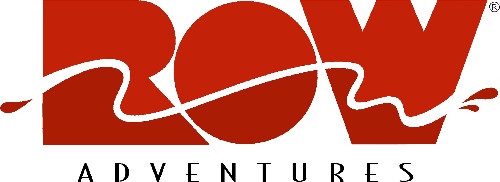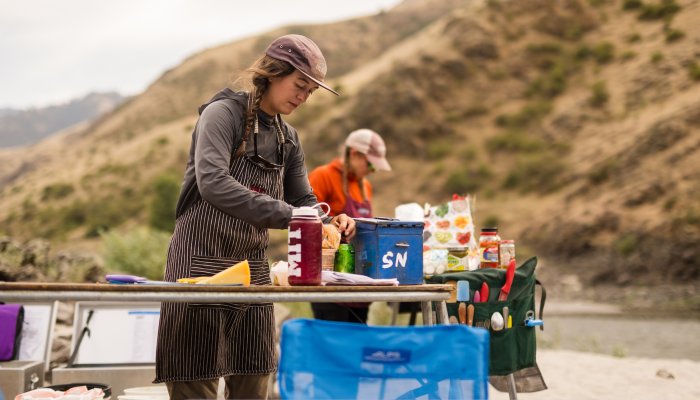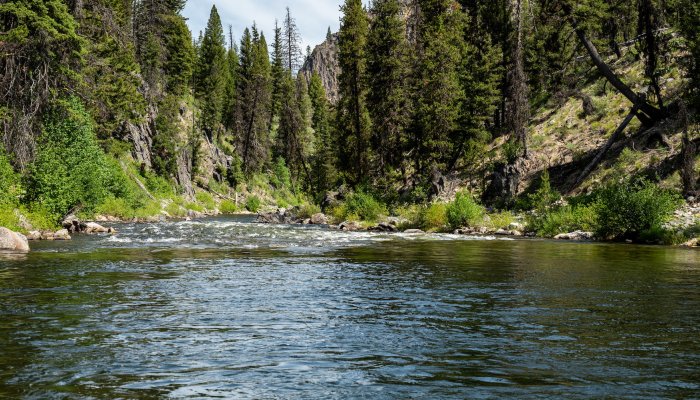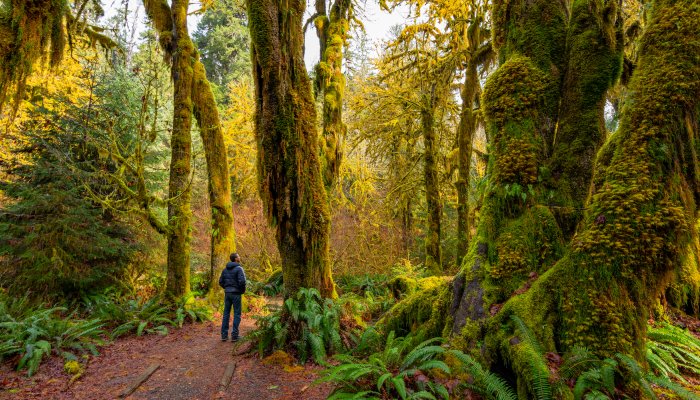Whitewater Rafting Lingo
When you embark on a rafting trip, it often feels as if you’re in a separate world. And you are! Swept away from the asphalt tributaries, the comforts of home and the cacophony of sounds resonating from urban living, you're instead riding life’s greatest highway: the river.
Complete with this whole new world you’re navigating is a new set of vocab. To help, we've created this rafter's guide to whitewater lingo. Now you'll not only be able to talk the talk with your friendly ROW guides and guests, but you'll feel at home on the river yourself.
We can't wait to talk boofs, dumptrucks and haystacks with you!
Get to Know Some Common Whitewater Lingo
Aced It: When someone does something really well, as in “You aced the move at Pin Ball today.”
Alluvial: As in an “alluvial bar”. Refers to material carried by running water and deposited by the river. When a side creek to a river does this it often creates a great camping area.
Around the Bend: When a guide uses this term it usually means s/he doesn’t actually know when you’ll arrive at camp, or a particular rapid, etc. “How far till camp?” “Should be just around the bend.”
Babble Eddy: See “eddy” below. When a conversation is going in circles.
Bar: “Let’s lunch at the bar above China Creek.” Refers to a geologic formation along the bank of a river comprised of sand or gravel.
Big Water: A large volume of water that has large features. Rivers with “big water” include the Snake in Hells Canyon, the Lochsa, the Colorado through the Grand Canyon, Cataract Canyon, Ecuador’s Upano, the Zambezi, etc.
Boil: Caused by water flowing over a deeply submerged rock or by construction, this is seen where water on the surface swells and looks as if it is actually boiling. Hence the “coffee pot” on the Rogue River.
Boof: When a raft bumps purposefully into a rock, or a kayaker uses the water’s cushion next to a rock to do a “boof move.”
Booties: Neoprene boots worn for warmth.
Breaking Wave: Unlike ocean waves that are waves of motion, river waves remain in the same place. A breaking wave falls back on itself with a constant or intermittent white froth.
Canoe: A traditional craft operated with paddles and ideal on lakes or smoother rivers.
Capsize: Describes when a raft has been flipped over upside down.
Carabiner: An oval or “D”-shaped clip used in climbing gear and found on river trips as an easy tool to clip things to the boat.
Cartwheeling: When a collision with a rock is inevitable, this technique turns the raft to spin around the rock rather than crashing into it.
CFS: Acronym for cubic feet per second. Knowing the CFS of a river tells you how big or small the volume is. 500-3000 cfs for example is a smaller river, while 50,000 cfs or more is huge. The Moyie and St. Joe are examples of small-volume rivers, while the Lochsa and Middle Fork are mid-range and the Snake in Hells Canyon is very big.
Channel: The part of the river that is deepest or most free of obstacles.
Chute: Where the river flows between obstacles like rocks, or a rock and a cliff. Usually narrow and sometimes fast.
Classification System: The river rating (from I-VI) of a series of rapids or even the river as a whole, which indicates how difficult the section is. Learn more about the Whitewater Classification System.
Clean: The route through a rapid free of obstacles or turbulence. As in: “You aced that run and ran it clean.”
Confluence: The area where two or more rivers meet.
Current: Moving water.
Deadhead: When rafts are taken downstream without guests, piloted only by a guide. We deadhead on the Middle Fork of the Salmon when the water is too low to carry guests and heavy gear from the farthest upstream put-in.
Dig: “Dig in team” shouts the guide! This means to bury your paddle deep in the current for a stronger stroke. Often heard from paddle raft guides on the Lochsa, St. Joe and Clark Fork!
Downstream: The direction the water in a river is flowing due to gravity.
Dry Bag: A bag which keep water out, and if closed correctly, keeps the contents within dry.
Duckie: An alternative name for an inflatable kayak.
Dumptruck: When a raft turns on its side and dumps everyone out, but then rights itself without flipping over.
Eddy: An area in the river where the shape of the river’s edge and contour of the bottom cause the current to turn around and go upstream.
Eddy Fence: The area between the downstream river current and upstream eddy current that often has water raised above the surrounding surface area. Found on large volume rivers like the Snake in Hells Canyon.
Falls: Short for waterfall, a drop in a river with vertical properties. Some we run include Velvet and Tappan Falls on the Middle Fork of the Salmon; Lochsa Falls on the Lochsa; Owyhee Falls on the East Fork Owyhee; Tumbledown Falls on the St. Joe; etc.
Ferry: Moving across a river. An “upstream ferry” is used to cross a river while losing as little downstream distance as possible. “That was a great ferry angle.”
Flip: When a boat turns upside down.
Flood Plain: An area adjacent to a river that sometimes floods when the river’s banks overflow due to high water from snowmelt or rain.
Ghost Boat: At difficult rapids guides will sometimes send a boat down without anyone piloting it. This is a ghost boat.
Gradient: A measurement of the vertical drop in the river. Fast-flowing rivers like the Lochsa and Middle Fork of the Salmon drop 20-40 feet per mile. Rivers like the Salmon River Canyons drops about 15’ a mile, making for “pool and drop” conditions. The Snake River in Hells Canyon has long lazy sections between rapids and a drop of 12’ or so per mile.
Groover: The latrine on a multi-day river trip. Name derives from the time when such devices were re-purposed ammunition cans that left a distinctive groove on one’s posterior. Find out more, read about the fascinating history of the Groover on American rivers.
Gnarly: An intimidating feature in a river such as a “gnarly hole” or “gnarly rapid.”
Hairy: Similar to gnarly, implies a challenging feature in a river, or a move that requires extra attention and skill. “Wow, that was a hairy move.”
Haystack: A wave that is caused by fast water running into slower current due to a drop in gradient. Usually makes for big, fun waves with no obstacles.
Hole: Also known as a hydraulic or reversal, a place where water drops over a rock and curls back on itself creating aerated, frothy water.
Lateral: A large wave that breaks at a strong angle relative to the main downstream current.
Recliner Position: When having an “out of boat” experience floating in a river, position yourself as if in a recliner chair, feet first and relatively flat.
Lead Boat: The first boat in a flotilla.
Ledge: Wider than a “falls” a ledge is usually formed of very hard, non-erosive rock that spans part or all of a river and makes for a dramatic drop.
Life Jacket: Old term for what are now called “PFDs” - personal flotation devices.
Line: “The best line in this rapid is left of that boulder.” The route through a rapid to avoid obstacles.
Low Water: When the water in a river is well below the normal level.
Good Looking Rubber: A compliment about the quality of a raft.
Oar: Not to be confused with a “paddle”, oars are used in tandem and are made of a long shaft and wider blade attached at the end.
Oar Raft: A raft that is controlled by a person who sits on a rowing frame that is in the center of the craft.
Outfitter: A person with a passion for running outdoor trips who has invested large amounts of capital and energy to do so. Their passion often outweighs business sense. Not to be confused with a gear or clothing outfitter.
Paddle: Unlike an oar, a paddle is shorter and held in the hand. A raft or canoe paddle are essentially the same with a single blade, while a kayak paddle has a blade at each end of the shaft.
Paddle Raft: A raft propelled by a group of people with paddles.
Paddle Captain: The guide for a paddle raft.
Pool: Found between rapids, this is a deep and quiet stretch of slow-moving river.
Pool & Drop: Refers to the character of a river that has calm stretches (pools) punctuated by rapids (the drop). Classic pool and drop rivers include the Salmon River Canyons, Snake River in Hells Canyon, Lower Owyhee and Clark Fork.
Portage: Some difficult rapids require that all gear is carried around or portaged to the bottom of the drop. Trips on the Upper and Middle Owyhee require portages.
Raft: A floating boat propelled by human power, or wind, made from a variety of materials. Whitewater rafting got its start in the U.S. because of the availability of inexpensive army surplus rubber rafts after WWII.
Rapid: Usually a highlight of a river trip! A formation in a river caused by gradient and either constriction or obstacles (such as rocks), or both.
Reversal: See “hole.”
River Rating: A measure of the difficulty of a rapid or river. The International Scale goes from I-VI with I as the easiest and VI considered “runnable with serious risk to life and limb.” Most guided river trips are in class II-IV rivers.
Rooster Tail: A somewhat rare, beautiful feature where currents meld to create a standing triangle of water in motion.
Run: “That’s a nice run” means a river that has a great section for boating, whether by kayak, raft or other craft.
Safety Talk: The talk given prior to starting a trip on a river that covers the techniques and things you need to know to help yourself should something go amiss.
Scout: To take a look at a rapid from land in order to find the best route through. “We eddied out to scout that gnarly rapid and find the best line. In the end, we decided to sneak it to the left.”
Sleeper: A rock that sits just under the water and is hard to detect.
Sneak: Sometimes a difficult rapid will have a “sneak route” where a more difficult route can be avoided.
Staircase: River water that pours over a series of ledges or rocks which resemble a staircase.
Standing Wave: When fast-moving water collides with slow-moving water a static and usually large wave appears.
Swimmer: When you fall out of a raft you become a swimmer.
Tail Waves: The final standing waves found at the bottom of a rapid, usually free of obstacles.
Take-Out: A river access, where the river trip ends. Often people are sad when they reach the take-out and the trip is ending.
Technical: Rapids with lots of rocks or other obstacles are considered “technical” and require a greater amount of skill for maneuvering than a non-technical run.
Throw bag: A bag filled with floating rope or line that is one of the key elements of river gear.
Trip leader: A God-like creature who shoulders the responsibility of making the magic happen.
Undercut: Mostly found on rivers with softer rock (limestone, sandstone), this refers to the place where current flows under a rock, overhang, or ledge. Best to avoid.
Upstream: Literally above you, this is the opposite direction of the current.
Voyageur Canoe: A large 20-35’ canoe that replicates those used by early fur traders in North America.
Whitewater: Often actually white in color, but on a muddy river can be brown, this is the churning, bubbly, water found in rapids.
Wrapped: When a raft collides sideways against a rock or ledge and gets stuck. Really embarrassing.



